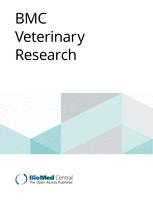Ver ítem
- xmlui.general.dspace_homeCentros Regionales y EEAsCentro Regional CórdobaEEA Marcos JuárezArtículos científicosxmlui.ArtifactBrowser.ItemViewer.trail
- Inicio
- Centros Regionales y EEAs
- Centro Regional Córdoba
- EEA Marcos Juárez
- Artículos científicos
- Ver ítem
First retrospective studies with etiological confirmation of porcine transmissible gastroenteritis virus infection in Argentina
Resumen
Background: In 2014, a notification of porcine transmissible gastroenteritis virus (TGEV) was made by the National Services of Animal Health of Argentina (SENASA) to the World Organization of Animal Health (OIE). The notification was based on a serological diagnosis in a small farm with a morbidity rate of 2.3% without enteric clinical signs. In order to determine if TGEV was circulating before the official report, a retrospective study on cases of
[ver mas...]
Background: In 2014, a notification of porcine transmissible gastroenteritis virus (TGEV) was made by the National Services of Animal Health of Argentina (SENASA) to the World Organization of Animal Health (OIE). The notification was based on a serological diagnosis in a small farm with a morbidity rate of 2.3% without enteric clinical signs. In order to determine if TGEV was circulating before the official report, a retrospective study on cases of neonatal diarrhea was performed. The selection criteria was a sudden increase in mortality in 1- to 21-day-old piglets with watery diarrhea that did not respond to antibiotics. Based on these criteria, three clinical cases were identified during 2010–2015.
Results: All animals that were evaluated presented histological lesions consistent with enteric viral infection. The feces and ultrathin sections of intestine that were evaluated by electron microscopy confirmed the presence of round particles of approximately 80 nm in size and characterized by finely granular electrodense nucleoids consistent with complete particles of coronavirus. The presence of the TGEV antigen was confirmed by monoclonal specific immunohistochemistry, and final confirmation of a metabolically-active virus was performed by in situ hybridization to detect a TGE mRNA encoding spike protein. All sections evaluated in this case were negative for PEDV and rotavirus A.
Conclusions: This is the first case series describing neonatal mortality with etiological confirmation of TGEV in Argentina. The clinical diagnosis of TGEV infections in endemic regions is challenging due to the epidemiological distribution and coinfection with other enteric pathogens that mask the clinical presentation.
[Cerrar]

Autor
Piñeyro, Pablo Enrique;
Lozada, Maria Ines;
Alarcón, Laura Valeria;
Sanguinetti, Ramon;
Cappuccio, Javier Alejandro;
Pérez, Estefanía Marisol;
Vannucci, Fabio;
Armocida, Alberto;
Madson, Darin Michael;
Perfumo, Carlos Juan;
Quiroga, Maria Alejandra;
Fuente
BMC Veterinary Research 14 : 292 (2018)
Fecha
2018-09-24
ISSN
1746-6148
Formato
pdf
Tipo de documento
artículo
Palabras Claves
Derechos de acceso
Abierto
 Excepto donde se diga explicitamente, este item se publica bajo la siguiente descripción: Creative Commons Attribution-NonCommercial-ShareAlike 2.5 Unported (CC BY-NC-SA 2.5)
Excepto donde se diga explicitamente, este item se publica bajo la siguiente descripción: Creative Commons Attribution-NonCommercial-ShareAlike 2.5 Unported (CC BY-NC-SA 2.5)


